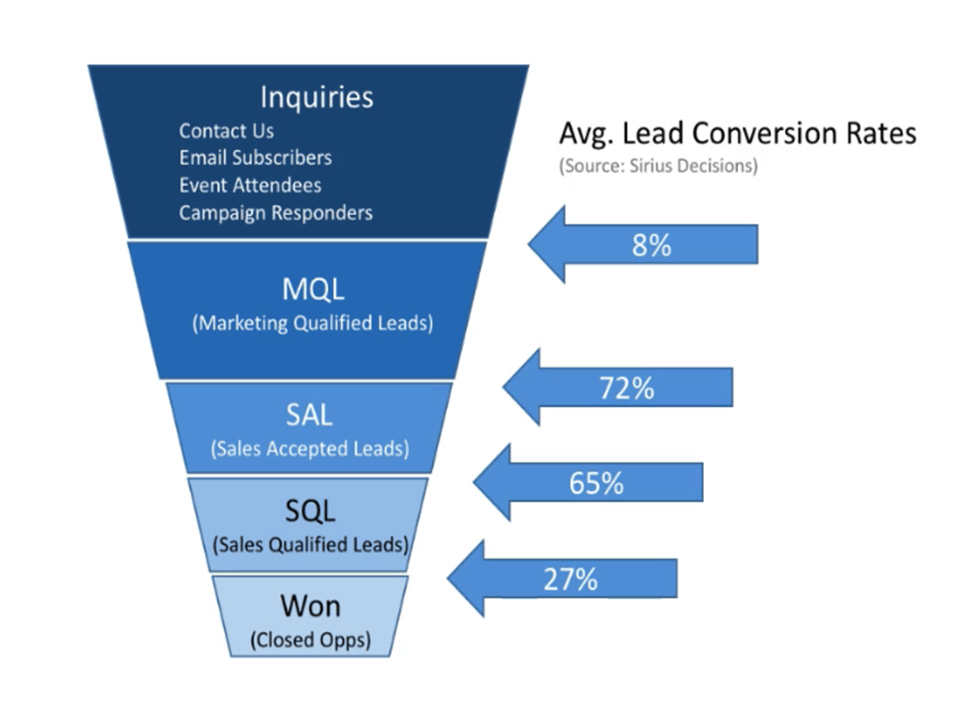Sales and marketing alignment has the potential to boost sales by up to 38%. Companies that align marketing and sales departments well register 36% higher customer retention rates than those who don’t.
But despite these benefits, only 8% of B2B companies create strong alignment between their marketing and sales departments. The costs of failing to align sales and marketing is extremely high.
Statistics show that without sales and marketing alignment, businesses can lose millions of dollars each year. Further, 75% of marketing leads that are generated from such content tend to convert at a very low rate.
On the flip side, getting sales and marketing teams to work together has a positive impact on your company’s growth, productivity and return on investment as seen in the image below.

But, how can your company create effective sales and marketing alignment?
It all starts with understanding how the two teams differ. In most instances, sales and marketing teams in B2B companies pursue different goals. They also perceive each other’s roles differently.
For instance, sales teams are traditionally pushed to achieve revenue goals while marketing teams are not. Instead, the marketing department is expected to think about the business in a more strategic way.
B2B businesses that want to effectively align sales and marketing functions have to address these core differences.
In this article, we explore 5 ways you can do this to generate more revenue for your company:
1. Link Sales and Marketing Goals to ROI
To align marketing and sales functions, you need to start by agreeing on the same goals. These goals should be linked directly to revenue and return on investment (ROI).
Essentially, both departments contribute to sales revenue directly or indirectly. However, revenue generation has traditionally been attributed to the sales function due to its direct involvement in the selling process.
Part of this process involves strategic market segmentation.
The reality however, is that the marketing department plays a key role in attracting and pushing prospects down the sales funnel. Measuring the effectiveness of their contribution towards sales revenue has however been a challenge for many B2B companies.
Aligning revenue goals for both sales and marketing teams provides a unique opportunity to identify strategies for achieving this. For instance, the two teams can agree on performance indicators to enable them to track the outcomes that their activities generate.
The key thing to appreciate here is that each function will use different strategies to convert prospects into buyers. As such, the focus should be on realizing the revenue goals that the company has set.
Recommended Reading: How to Determine Your Target Market For Your Business
2. Redefine the Sales Funnel
Sales and marketing teams have different roles. As such, their definition of the sales funnel tends to differ. Each team has its own idea of the activities that have to be completed in order to push leads to the next stage of the funnel.
To create sales and marketing alignment, B2B companies should bring their sales and marketing teams to agree on the stages of the sales process and what each stage entails. This makes it easier to align marketing and sales as each team understands its roles, the leads to be generated and how those leads would be converted.
Though each B2B company will have its own sales funnel, the stages are basically the same as reflected in the image below.

3. Conduct Joint Meetings
In most companies, sales and marketing teams hold separate meetings to plan their activities. This makes it hard for the two teams to talk to each other directly. Instead, they end up working in silos, causing inefficiencies that damage the business.
Marketing teams do not see how their efforts can be turned into tools that sales teams use to get more leads and sell more. On the other hand, sales teams rarely get a chance to influence the marketing content to make it more responsive to prospects’ needs.
Sales and marketing alignment can only happen when each team understands what the other does, and how their activities affect their work and the company at large. The best way to boost this understanding is to conduct meetings that bring the two teams together.
Such meetings would ensure the two teams are continually aligned. The goal is to ensure they agree on and have a shared understanding of:
- Revenue goals
- Team expectations
- Strategies or tactics for meeting revenue goals
- Measuring performance
Sharing information between sales and marketing teams should be encouraged at all times. When they communicate well, both teams can gain valuable insights that enable them to contribute effectively for revenue goals.
Where physical meetings are not tenable, B2B companies can find their ideal free software to facilitate internal communication between sales and marketing teams. This means sales teams can share feedback on lead quality while marketers can gather more insights about the target audience from sales reps.
Here are some useful tips to help you conduct successful meetings that align marketing and sales teams:
- Encourage teams to interact in a friendly manner
- Have a clear agenda for each meeting and share it in advance
- Have a spokesperson for each team
- Recognize and reference service level agreements for each team during meetings
- Agree on actionables at the end of each meeting
4. Agree on Lead Definition
To get more revenue, B2B companies must generate more leads.
In B2B selling, both sales and marketing teams are involved in lead generation. Even so, statistics show that 23% of sales teams say marketers need to send them better quality leads.
Recommended Reading: How to Build a Sales Cadence that Converts Leads Efficiently
On the other hand, 22% of marketers say sales teams need to do a better job in following leads up. This is a clear indication that each team has its own definition of what constitutes a lead, hence the need for communication.
To align the two teams, you need to ensure they have a common understanding of B2B sales leads. As a general practice, marketers generate leads and hand them over to sales teams for nurturing and deal closure.
As such, failure to agree on what constitutes a good or high value lead can quickly escalate to unending arguments and and blame games. Marketing teams will be blamed for not sending sales the leads that have the potential to to convert.
On the other hand, the sales teams will be blamed for not closing deals on leads that the marketing team sends their way.
To create sales and marketing alignment, B2B companies need to determine the characteristics that define each lead type throughout the sales process as shown below.

There are three types of leads:
- Marketing Qualified Leads (MQLs): These are often generated by marketers at the top of the sales funnel. MQLs are defined using a set of characteristics that reflect their interest as potential customers.
For B2B companies, these characteristics would include the industry that prospects are in, the level of decision making, and nature of engagement that prospects have with the company. B2B companies identify MQLs by tracking digital strategy activities like white paper downloads, article shares and social media engagements.
- Sales Accepted Leads (SALs): These sales leads are often outlined by the sales teams. Based on their assessment, these are leads that have the potential to convert but require followup.
- Sales Qualified Leads (SQLs): These leads are outlined by the sales teams. They are high value leads at the bottom of the sales funnel that will convert into customers.
Pro tip: See all marketing terms in our Marketing Glossary of terms
5. Enhance Sales Team Participation in Content Creation
In B2B selling, content plays a key role in attracting and nurturing leads. However, most companies leave this role to the marketing team, with little or no participation of the sales teams.
Recommended Reading: How to Improve Content Marketing Project Management
The results are devastating – 70% of the content that companies create goes to waste.
While the content creation task lies with the marketing department, it is important to do so in consultation with the sales team.
The reality of the matter is that the content companies create is mostly used by sales reps. Whether the company is developing content for its digital strategy like landing pages, white papers and blog posts or preparing product demos and descriptions, sales teams utilize content as they move prospects through the sales pipeline.
B2B companies can enhance sales and marketing alignment by involving sales in content creation. Sales reps spend more time interacting with customers directly. As such, they have a better grasp of their information needs.
When this happens, sales teams become a valuable resource that helps enhance marketers’ understanding of customers including their questions, objections and needs. By working together, sales and marketing teams can define the content that should be provided in each stage of the sales funnel and make it customer-centered.
This will result in efficiency in the selling process and lead to more sales revenue for the company.
Final Thoughts
Sales and marketing team alignment is a great way to generate more revenue and grow a B2B company. Working towards fostering collaboration between these two departments offers numerous benefits to B2B companies.
It makes it possible for the companies to gather unique insights about customers, optimize marketing and sales strategies, grow the business and ultimately generate more revenue. If your company has not started aligning sales and marketing functions, leverage the five strategies discussed above to achieve this goal.
